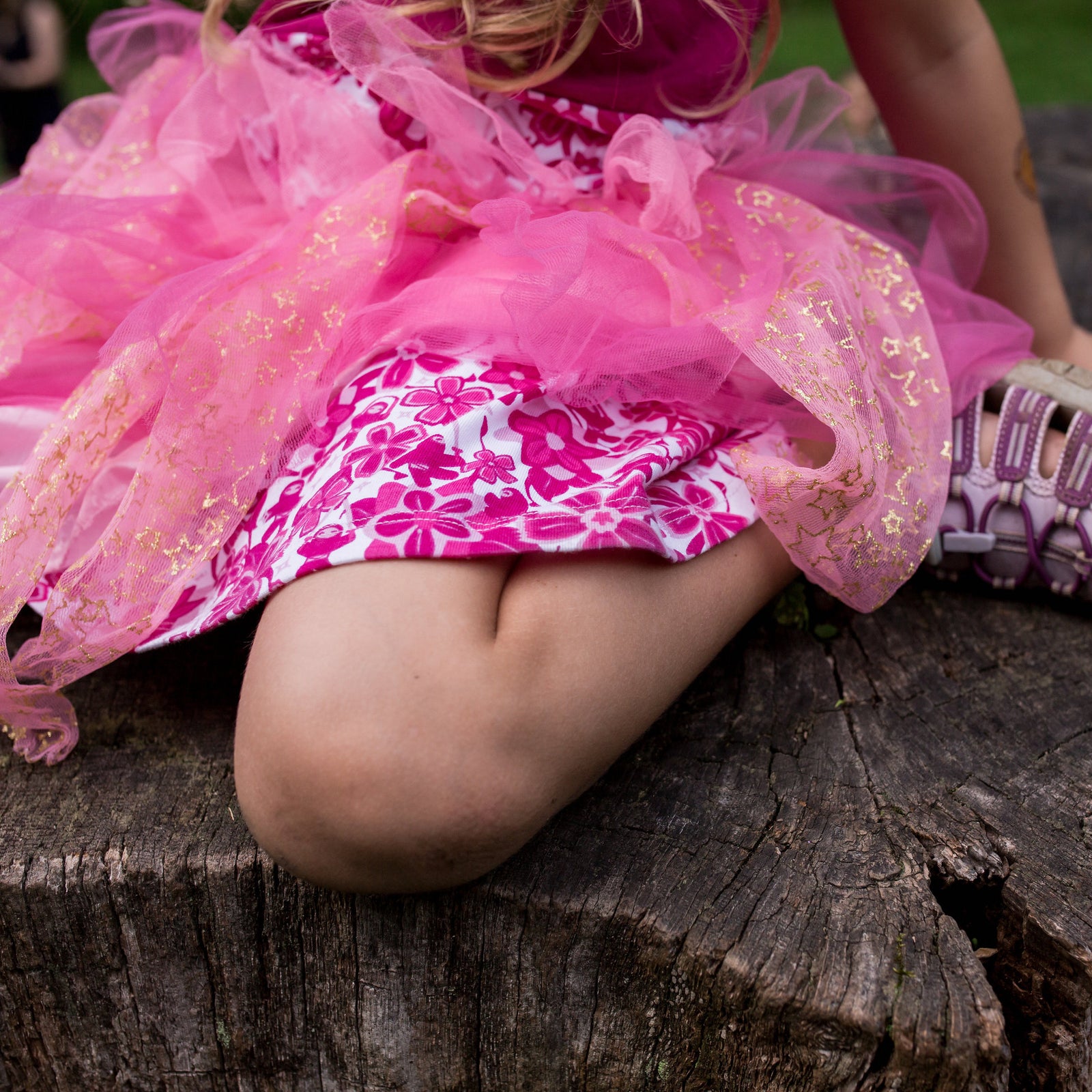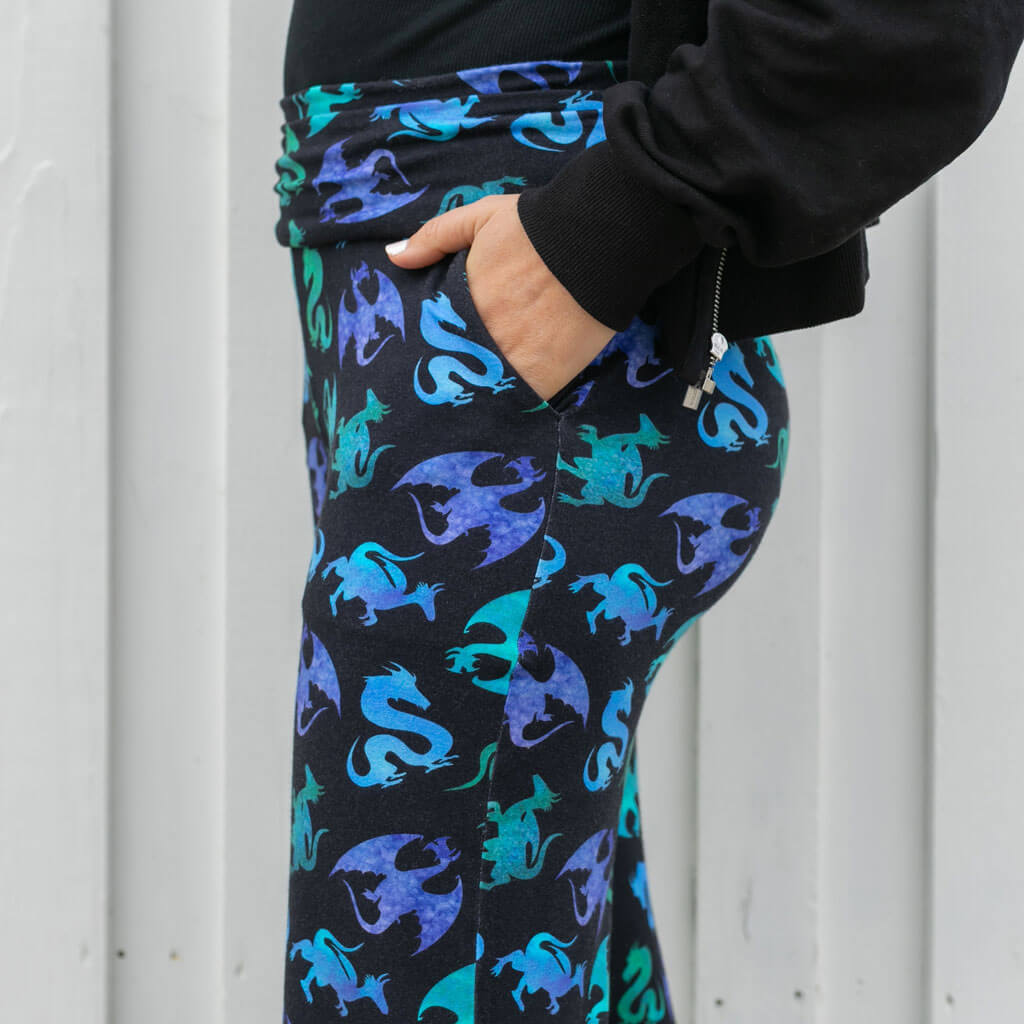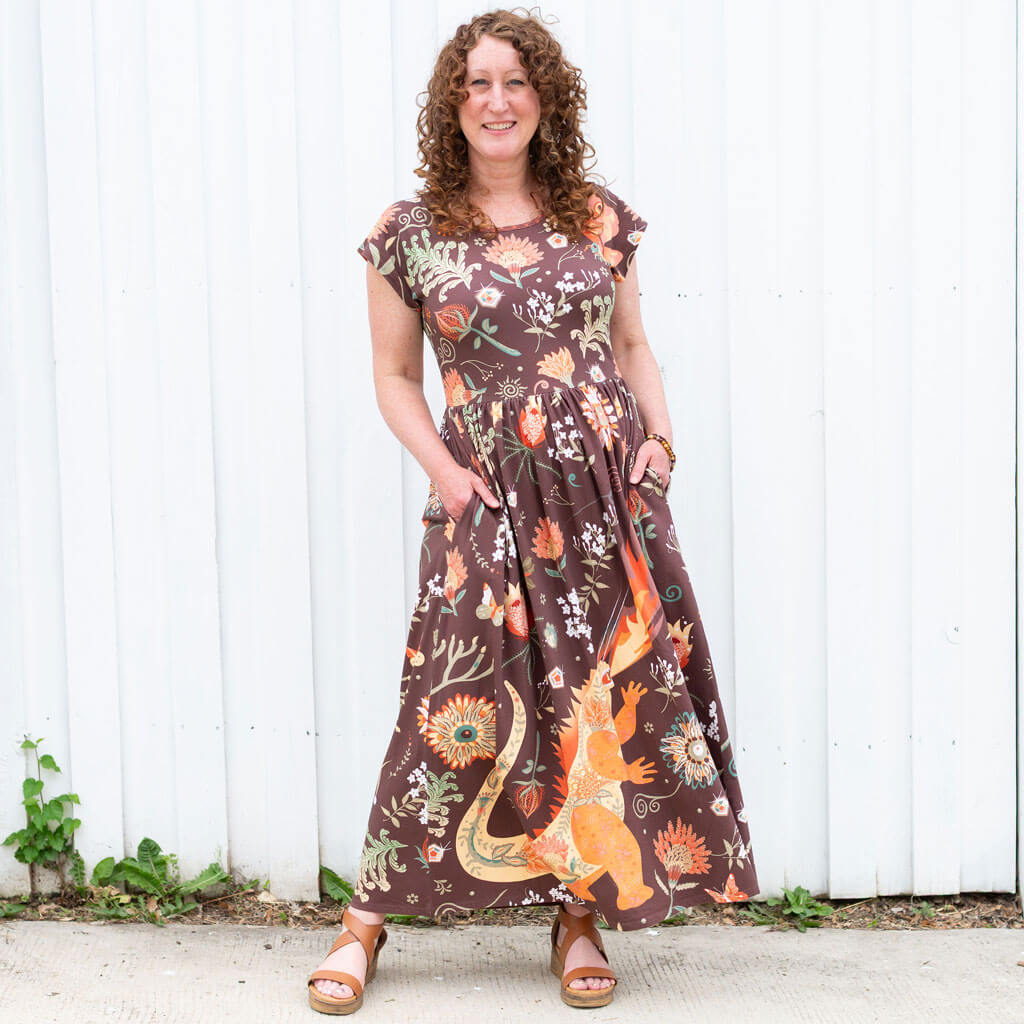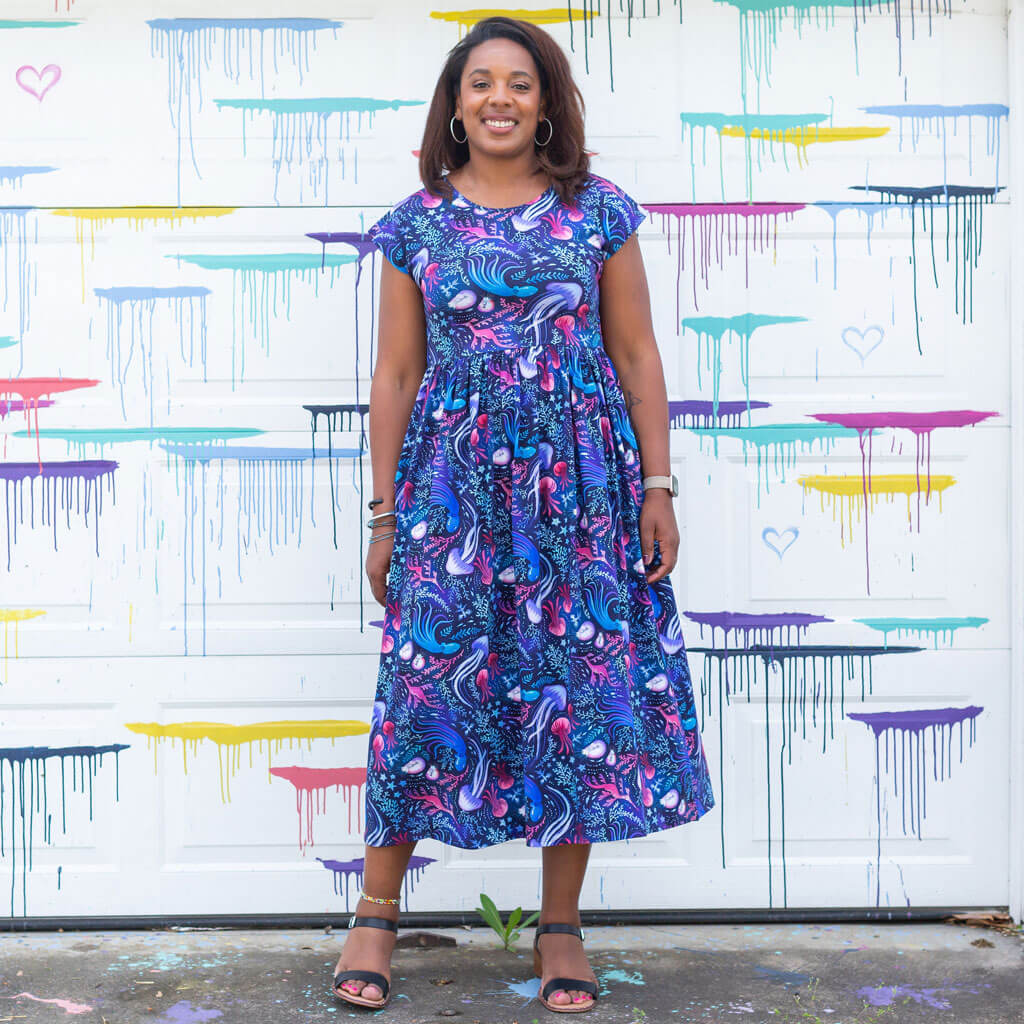Shop Now
New
Sale

Pink is a Problem. Or is it?
December 03, 2017 3 min read 17 Comments


I was sitting at Legoland, drinking my coffee while the kids were playing in the castle ropes course. Across from me was a stand with toys and dress-up gear - directly facing me, a set of toy pirate shields. One was yellow and one was pink.

The pink one annoyed me, but I wasn’t sure why. It was just a pink shield for kids who like to play pirates and who also like pink.
I sat there a pretty long time (the kids love that ropes course), and it finally occurred to me. The pink shield was annoying because it was next to the yellow one. If the yellow one hadn’t been there, the shield wouldn’t have annoyed me at all. Pink is a color and yellow is a color, and they are both great colors. But pink in our culture has meaning, and that meaning is “I’m a girl.”
That meaning forces a choice onto children that they don’t need to make. It’s not a choice about getting a toy in a favorite color. It’s a choice about gender identification.

Pink has now become so strongly identified with femininity and in particular, being a girl, that to select something in pink is symbolic of identifying as a girl. It means that a child looking at the two shields isn’t seeing just a pink shield and just a yellow one, and choosing the color they’d rather have. It means that the child is saying “I’m a girl and I like this shield” or “I’m not a girl and I like this shield.”
Forcing a child to declare their gender identity via the color of an object is a choice kids don’t need. It adds unnecessary anxiety to the mental load not just of the child - whose choice is now declaring their gender identity - but to everyone around them watching them make that choice and considering its implications. A child who just wants a pirate shield now also has to declare whether they identify as male or female. A girl can’t just pick the yellow one - she will feel that she’s supposed to pick the pink one because it’s there for girls. And a boy can’t really choose the pink one even if he likes it better - he’ll be telling the world that he’s not identifying as a boy.

Both pirate and girl at the same time. No pink necessary.
Sure, we could brush this problem off nonchalantly and say, “Who cares what pink means? Get the one you want, boys and girls.” But it’s not that easy. There are few adults who are confident enough in their own self-identity to wear whatever they want regardless of what others may think or say. Young children, most of whom are just beginning to understand social cues and symbols and whose understanding of the world tends to be blunt and literal, have difficulty understanding that holding a pink shield doesn’t have to signal femininity.
And so the attempt to empower girls by giving them a “girl option” has actually had the opposite effect - what it really does is take their choice away. The choice should be: “Do I want to be a pirate today?” But now it's: “Do I want to be a pirate girl or a pirate boy today?”

The solution is to show kids that there are many ways to be a girl or a boy - and that pink is an awesome choice regardless of gender. At Princess Awesome, sometimes we use pink, because it can be gorgeous for rockets lifting off or ninja hiding in flowers. But it’s not the only option, because it’s not the only way to be a girl.
17 Responses
Draig Goch
September 07, 2019
Bethany’s comment is spot-on. I was the Tomboyish girl when I was little, but nobody thought twice about my Ghostbusters toys/shirts, and I also had She-Ra stuff to play with. Girls didn’t have to choose gender-specific stuff even in the mid-80s. Boys don’t get those options. And if you really want to look at “the pink problem” start with the pink triangle.
Alex
March 07, 2018
My husband leads kids’ color-coded field days each year and he chooses pink for his color every single year to show the boys who land on that team that it’s totally ok. Love him :)
Alina
March 02, 2018
Please talk to me about a costume decision path I led my kid down recently. I’m wondering if there is a better way I could have handled this. She said for a while she wanted a Mickie mouse and a Minnie Mouse costume. When I got around to making it I asked her to choose which one she wanted me to make bc I wasn’t planning on making both. She chose Mickie mouse then changed her mind to Minnie Mouse. Then I asked her if she knew what Minnie Mouse wears and if she wanted to wear that too. She didn’t, and when she found out Minnie wore a skirt and Mickie wore pants she decided on Mickie mouse again. Then later I was thinking— should I have presented it differently? Like I’m kind of uncomfortable that I made it out like boys wear pants and girls wear skirts- period. Except she identifies clearly as a girl, likes skirts and dresses on occasion but mainly prefers pants and knows girls wear pants all the time, and she sees her mom (me) in jeans all day everyday except on occasion.
Bethany
February 23, 2018
From the perspective of having a boy and having a friends who have girls, this article misses the mark completely for me. See the girls can pick whatever they want from wherever. No one honestly cares. As a young girl I played just as much with Legos and cars as I did with dolls. I HATED pink.
My son however will get ridiculed if he wears a princess shirt. A girl who wears dinosaurs or starwars, it monsters, she’s cool. But the pink option hurts boys more than girls because to society now, a girl with a regular pirate shield is fine but a boy with a pink one is blasphemy.
Here’s the thing though. I’m going to let my son pick whatever he wants. If it’s the pink shield then I’ll just have to swallow my own personal disdain for the color (though I may dislike yellow even more in relation to your story) and let him enjoy. He’s a kid. Let him pick, learn to be a person and accept that everyone is different and has different expierence and should be seen as special for that.
Abby
February 08, 2018
I agree that this tactic can be frustrating and even damaging to children, but I don’t think the drive on the manufacturers’ part is rooted in a deep-seated need to enforce gender binaries. Rather, retaining established binaries creates two distinct demographics to sell to. I know when I was a kid, my siblings and I shared basically everything, because, well, there were five of us and buying five copies of anything can be prohibitively expensive (especially at an amusement park, where those stupid foam swords are probably running like $20 a pop… our parents had a firm rule against asking them to buy us anything at theme parks). So the toy companies could only sell a given product to our family once. But now, let’s say someone with two kids, a boy and a girl, decides to buy them a toy, only to see that the options are all gendered. Suddenly, sharing becomes out of the question (in the minds of many people, alas), and two toys are sold. Cha-ching.
Colleen
February 05, 2018
I actually feel that it’s much easier for the girl to pick the yellow shield these days, but it’s sad that it’s still taboo for boys. This feeling of girls being “less than” and boys being ashamed to be associated with anything feminine is the real problem.
Maureen
January 12, 2018
You all are making a Grandma very crazy!!! My Granddaughter decided at 4 she didn’t like dolls so stuffed animals were her joy. Let the kids be kids and stop over thinking every little bit of the world. Oops there goes the pink in Lucky Charms, too! LOL
Emily
January 11, 2018
I love pink, but not for my daughter. I guess it’s rebellion against exactly what you’re talking about here. I don’t want her limited. We received all pink hand me downs for her and I’m so grateful, but she needs other choices. The worst are pink Duplos/Legos. Why do we need a girl specific Lego? I thought all Legos could be for girls!
Kath
January 11, 2018
My problem is that there was just yellow or pink. If there had been a green one and s purple and a blue then that’s giving choices. Just having s girl cookout and a boy color makes it gendered.
Shelby
January 11, 2018
That’s great if some kids don’t have a problem with choosing a color. I myself have given my son hand-me-down pink stuff to some degree, as well, and my oldest daughter loves green. However, my daughter also has experienced a child telling her that her green shoes were “boy shoes” and that really shook her up. My son also wanted the cute animals from the Lego Friends sets for Christmas…until he started hanging out with boys his age a little more often and he changed his mind and only wanted the dogs from the regular Legos. And don’t even get me started on my own childhood! Parents do what we can, but culture still has an impact, like it or not. Some kids are more susceptible to it than others (I was a stubborn weirdo myself). I like this article.
Linda Levine
January 11, 2018
Thank you for this, it absolutely has been my experience that pink as a choice between only two colors is an issue. My son liked pink very much until he went to school where he learned that to pick pink for some things was OK but definitely not if it was between pink and blue. Pink (still!) has the connotation of frilly and dainty, the opposite of how boys want to be seen. Sure, it’s changing some but not enough, just go look at the clothes in a department store. I appreciate you pointing this out and will share your comments.Vanessa
January 11, 2018
Poor pink. All it tries to do is bring some cheerfulness to the world, but it is always getting picked on. What is interesting to me is that in all of my nearly four decades of life I have not once heard the mom of a boy wax poetic about how blue is a forced color choice for boys, or what the long-term emotional ramifications are of the boys selecting an item seen as masculine, or why there aren’t more items for boys featuring fairies, flowers, and especially glitter. I am delighted that my daughter loves pink and sparkly things and we have a lot of fun playing princesses and dinosaurs. Rather than moaning about how everyone thinks pink signals weakness, let’s just go out there and show the world that it doesn’t!
Kathy Pearson
January 11, 2018
Thank you for a very good post. I agree with you all the way. One thing that I don’t think you emphasized enough is that most boys would never choose pink – emasculating – and, yet, girls choose blue all the time. What has been (and for many still is) the worst thing a boy can be called? A girl. “You throw like a girl,” for example.
I congratulate “K” above for the fantastic modeling she is doing for her children. However, because she has done that does not make your post irrelevant or “wrong”. When our children were young, for a long time, I couldn’t understand what the fuss was about with children watching TV – “Just turn it off.,” I would think. Finally, I watched a wonderful program, with Ed Asner narrating, about the effects of TV on children and learning – and wham! It hit me that I might have been turning off the TV and providing many varied experiences for my children, but lots of parents were not doing that.Unfortunately, there are far too many people who are still using sterotyping with their children – be it by color or types of toys or professions to which they should aspire or…
Theresa
January 11, 2018
Pink is not the problem – parents who perpetuate the belief that “pink is for girls” are the problem. My kids have the inclination to believe in the “pink vs. blue”, boys & girls separation, but I am always pointing out, in very simple terms that any toy, any clothing, any color, any sport, any activity is for whoever likes it. I have one child who refused to wear pink for a few years, but now as a maturing teen, she wears what she likes regardless of what others expect. She has black, pink, blue, green, purple and more in her wardrobe now. I feel successful as a parent in that instance, but I still continue to try to teach my younger child the same. She still likes pink, but has recently relented that she loves green and chooses more green items when she has the opportunity. It’s seems easier for me to teach my children a way of thinking (open-mindedness) than to change society.
K
January 11, 2018
Dumbest thing I’ve read today. We adults make this all too complicated. One of my sons (I have four) has never had any issues choosing pink or purple as his favorite colors and one of my daughters (I have five) prefers bold colors over pink and purple. They’ve never had anxiety over color or gender identification – primarily because we don’t “do” that here. Boys are boys and girls are girls and colors are just colors.
My sons wear pink handmedown boots.
My toddler daughter wears adorable black boy shoes.
Two of my sons have purple bikes.
My youngest son has a pink helmet, and his sister a yellow one. My goodness. I’m so tired of this gender junk.
Y’all have lost me on this one. Unsubscribing.
Bobbi
January 11, 2018
All. Of. This!
I have a girl and a boy, 2 years apart. We try to get them the same thing when they express interest in an item, regardless of the gender implication. They recently changed schools and gender stereotypes are seeping in, making parenting that much more challenging. You see, we want our kids to be free to be whoever they want to be, without feeling the need to conform to any preconceived notion of what that self should be. We were doing fine, but society is hurting up against the values we encourage. I take smalll comfort though when my son will ask to wear a bow in his hair and to have his nails painted and then proceed to declare that it’s time to fight. I take small comfort in the times when my daughter rock her gi (martial arts uniform) or play in her kitchen while declaring that her new favorite colors are pink and purple (ok, maybe o cringe a little on the last part). The point though is that o want them to feel comfortable with their choices because they feel true, even in a world that is forcing these binary options.
Leave a comment
Comments will be approved before showing up.
Subscribe
Sign up to get the latest on sales, new releases and more …






Draig Goch
September 07, 2019
Bethany’s comment is spot-on. I was the Tomboyish girl when I was little, but nobody thought twice about my Ghostbusters toys/shirts, and I also had She-Ra stuff to play with. Girls didn’t have to choose gender-specific stuff even in the mid-80s. Boys don’t get those options. And if you really want to look at “the pink problem” start with the pink triangle.